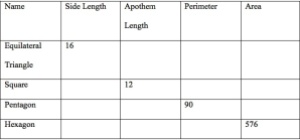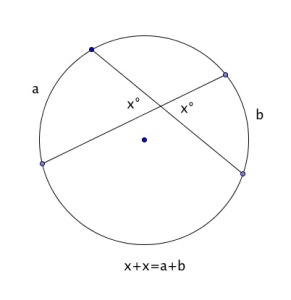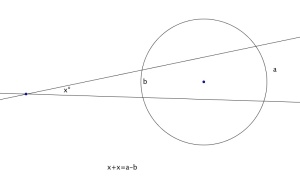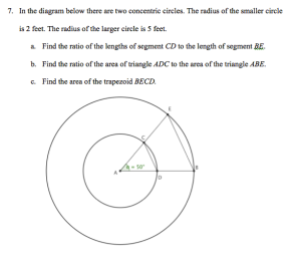Last week it felt as if my Geometry class as making great progress in examining radians, looking at areas of regular polygons, dealing with a new vocabulary word (apothem), and generally doing a nice job of making connections – especially with the right triangle trig that we are now leaning heavily on. Well, Friday morning we had a conversation that I am still unpacking. On their HW from Wednesday night one of their tasks was to complete the table below:
When my students asked me to review this problem I started by drawing an equilateral triangle and its apothem. I know that it is more efficient to use our knowledge of the triangle area formula, but I wanted to reinforce our new formula that the area of any regular polygon is half of the product of the apothem and the perimeter. Unfortunately, when I drew the picture they asked me why I drew what I drew. They wanted instead to draw an equilateral triangle and its altitude. I followed this suggestion by drawing the following figure: 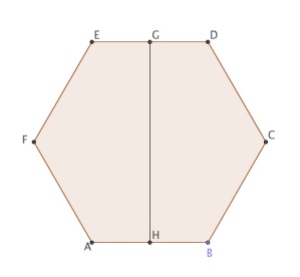
They were quick to identify that this is not, in fact, an example of an apothem. Pretty much everyone agreed to this quickly. Instead they instructed me to draw the following figure:
I have been trying to figure out why so many made the same mistake and, after talking to one of my Geometry teaching colleagues, I have a theory. I keep drawing pictures like this one: 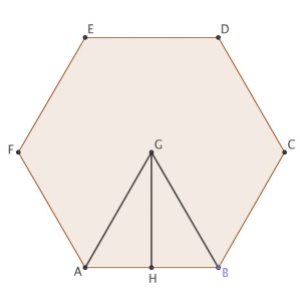
I fear that seeing this drawing repeatedly has somehow convinced some of my students that the altitude of a triangle is simply the apothem. I know that I pointed out the similarities between the terms when I was trying to help them remember this new word. I talked about how altitudes and apothems were each perpendicular to a side (and that they both begin with the letter a). However, I do not know why some students would simply draw an altitude and figure that, for some reason, we are now calling it an apothem. So this was a disappointing way to start the day. I think I feel a little better now that I have a feeling where the triangle mistake came from. Have any of you experienced something similar?
The other disappointment came when they asked me to address the next HW question. They were again asked to fill out a table, Here is the second HW problem:
I suspect that most of you see some similarities between the first two HW questions. My students did not. I understand that when you are learning something new it is hard to step back and see big picture things going on. However, I also know that this type of HW problem is tedious and I hope that my students are thinking of ways to streamline the process. Instead of recognizing that the triangles in the two problems are in a 1 to 2 ratio and using our knowledge of similarity and scale factors, many students simply reset and did the problem from scratch. I try really hard to build in these sort of connections in my assignments and my tests. I do not expect students to recognize that in October, but I would hope that they do by May. I’d love some advice about how I can better help my students look for these types of connections. How can I help them step back a bit and see these connections?
Back at it 8 AM tomorrow. I’m optimistic we’ll have a good week. Test on Wednesday – I want them to really kill it on this one.

